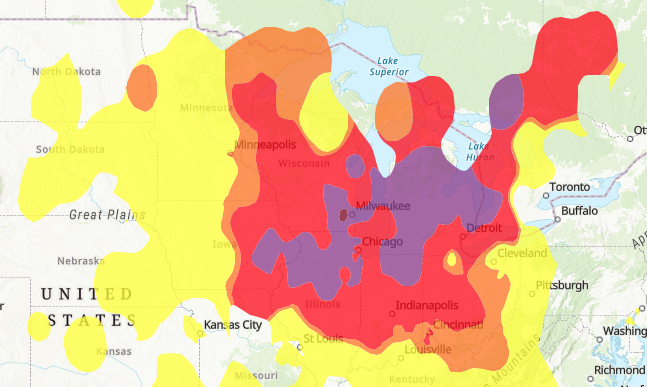Canadian wildfires causing air quality index to spike throughout Midwest, but numbers in Quincy remain normal for now

QUINCY — If you noted a haze around Quincy Tuesday, you’re not alone.
“When I walked in this morning about seven o’clock, it didn’t look bad,” said Dr. Julia Montejo, an allergy, asthma and immunology specialist for Blessing Health. “But then I was looking out the window when I was discharging in a patient from the clinic, and I was like, ‘Wait a minute. What’s going on? Is it going to rain? Why is it so hazy?”
The National Weather Service said around noon Tuesday that air quality across a wide swath of the Midwest is “unhealthy/very unhealthy” today due to smoke from wildfires in Canada filtering south.
“Though forecast specifics will change, similar conditions are expected the next couple of days,” the National Weather Service said in a tweet.
Jerrod Welch, public health administrator for the Adams County Health Department, said he has received no public health guidance from the Illinois Environmental Protection Agency as of 4 p.m. Tuesday.
As of 3 p.m. Tuesday, AirNow.gov said the Air Quality Index in Chicago was at 258 — considered to be “very unhealthy.” Numbers over 230 were found in Joliet, Aurora, Elgin, Lake County and the south and west suburbs. Rock Island-Moline had an AQI of 229, and Peoria and Bloomington/Normal were at 220. Springfield was at 150.
AirNow.gov said the Air Quality Index in Quincy and at Mark Twain State Park near Florida, Mo., was at 46 at 3 p.m. The AQI in Keokuk, Iowa, however, was listed as “unhealthy” at 166, and it was also listed as “unhealthy” at 179 at Lake Sugema near Keosauqua, Iowa.
“The particles you’re seeing in places like Chicago or Minneapolis or Quincy are very, very tiny,” Montejo said. “They’re so lightweight. They’re so buoyant. They’re 30 times smaller than the diameter of the human hair. But when they all get together, there’s this huge cloud that kind of settles over everything/ These tiny particles can penetrate deeply into the lungs.”
The New York Times reported Tuesday that the Air Quality Index in Chicago reached 209 by noon, the worst reading of any major city in the world for the day, according to IQAir, a Swiss air-quality technology company.
The Air Quality Index measures the density of five pollutants: ground-level ozone, particulates, carbon monoxide, nitrogen dioxide and sulfur dioxide. It was established by the Environmental Protection Agency to communicate to Americans the cleanliness of the air they are breathing each day. Pollution monitors are at more than 1,000 locations across the country.
When the index hits 101 or above, the outdoor air remains safe for many, but older adults and children are at increased risk. Those with heart and lung disease may also be at greater risk. A number above 200 is considered “very unhealthy.”
The best thing to do to prevent breathing in pollutants is to stay indoors. If you must go outside, put on a mask. A surgical mask, scarf or bandanna won’t do much to protect you from pollutants. Instead, use a N95 face mask or respirator mask. Cover both your nose and mouth.
“People who have any kind of airway challenge — the elderly, people who have any lung diseases like asthma or COPD, anybody with allergies — can be adversely impacted by this,” Montejo said. “Folks who are, quote unquote, healthy can easily have symptoms — coughing, chest tightness, runny noses, nasal irritations, eyes itchy and watering. Those particulate items are highly irritant.”
Montejo suggests people affected by the air quality would do well to spend Tuesday and Wednesday night at home. She even suggests pets who typically spend the night outside should be brought inside.
The Minnesota Pollution Control Agency on Tuesday issued its 23rd air quality alert of the year — a record high — as a layer of smoke hovered over much of the state. David Brown, an air quality meteorologist at the agency, told the New York Times that Minnesota usually issues no more than two or three air quality alerts a year. The previous record was 21 alerts for all of 2021, he said.
Brown said the wildfire season in Canada usually doesn’t even begin until early July, so Americans in northern states may have to face the threat of poor air quality for weeks to come.
“There are a lot of fires that are getting very large, with the hottest days yet to come,” he told the New York Times. “These fires will likely continue to grow.”
Wildfires are a common cause of extended periods of unhealthy air. In 2020, smoke from wildfires pushed the index above 400 around Portland, Ore., while the levels in the San Francisco Bay Area hovered between 200 and 300.
Visit http://airnow.gov for the latest.
Miss Clipping Out Stories to Save for Later?
Click the Purchase Story button below to order a print of this story. We will print it for you on matte photo paper to keep forever.

